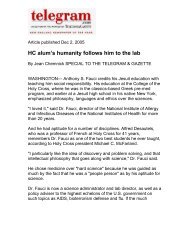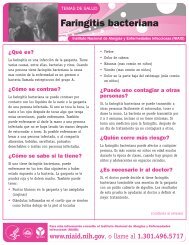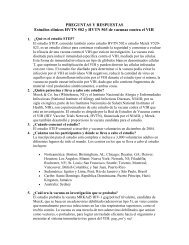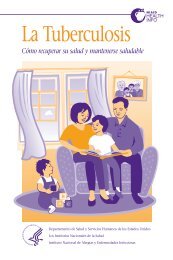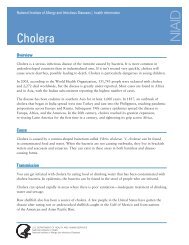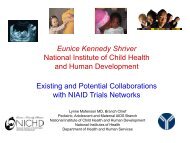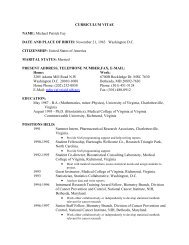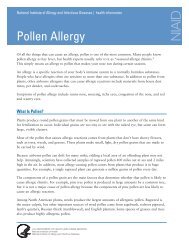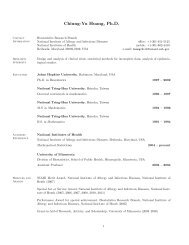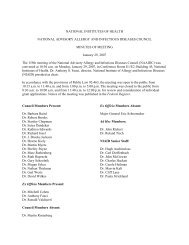Sample Grant Application - NIAID - National Institutes of Health
Sample Grant Application - NIAID - National Institutes of Health
Sample Grant Application - NIAID - National Institutes of Health
You also want an ePaper? Increase the reach of your titles
YUMPU automatically turns print PDFs into web optimized ePapers that Google loves.
Principal Investigator/Program Director (Last, first, middle): Dow, Steven, W<br />
infection in the GI tract. Since Bp is known to be able to infect a number <strong>of</strong> different cell types, we do<br />
not expect problems with either the cell invasion or cytopathicity assays.<br />
Aim 2. Identify intestinal target cells for B. pseudomallei during acute and chronic enteric<br />
infection. Rationale and Hypothesis. Identifying infected cells in the gut is critical to understanding<br />
how Bp establishes and maintains enteric infection. To address this question, we will use Bp strains<br />
engineered to stably over-express GFP or RFP, combined with confocal microscopy and flow<br />
cytometry to identify Bp-infected cells. Examining intestinal tissues over time following infection will<br />
allow us to assess early and late targets for Bp infection. We hypothesize that Bp will infect both<br />
intestinal epithelial cells and monocytes and macrophages during acute infection, while submucosal<br />
macrophages will serve as the primary target cells for chronic infection.<br />
Objective 2.1. Identify target cells for Bp infection during acute and chronic enteric infection.<br />
Experimental Approach. BALB/c mice (n = 4 per group per time point) will be inoculated orally with 5 X<br />
10 5 CFU Bp strain 1026b engineered to over-express GFP (see Dr. T. Huang, Letter <strong>of</strong> Collaboration).<br />
Inoculated mice will be euthanized on d1, d3, d7, d14, and d30 after infection. Tissues will be<br />
processed for immunohistochemistry (IHC) or flow cytometry, using previously published techniques in<br />
our laboratories (49-51). Briefly, sectioned tissues from the GI tract, mesenteric LN, and spleen will be<br />
examined using a laser scanning confocal microscope (Zeiss LSM 510 META, 4-laser microscope)<br />
available in the laboratory <strong>of</strong> Dr. Gonzalez-Juarrero (Co-Investigator on this grant). Dual labeling IHC<br />
will be utilized to identify cells containing labeled Bp, including the following relevant cell markers:<br />
F4/80 (mature macrophages); Ly6-G (neutrophils), cytokeratin (epithelial cells); CD11b and Ly6-C<br />
(monocytes); CD3 (T cells), and CD11c and DEC-205 (DC). We will also use multicolor flow cytometry<br />
to further define the population <strong>of</strong> infected cells, using techniques reported previously(52).<br />
Expected Results, Interpretation, Possible Pitfalls. We expect that Bp will be found primarily within<br />
infected intestinal epithelial cells at all levels <strong>of</strong> the intestine on days 1-3 after inoculation, especially in<br />
the ileum and large intestine. This result would be consistent with direct invasion <strong>of</strong> intestinal<br />
epithelium as the primary mechanism <strong>of</strong> initial enteric infection. By days 7-14, we expect to observe<br />
more infected monocytes and macrophages, particularly in the ileum, cecum and large intestine, while<br />
infected intestinal epithelial cells will have largely disappeared, consistent with immune elimination or<br />
apoptosis. From day 14 onward, we expect that the only Bp infected cells in the gut will be<br />
macrophages located in submucosal layers <strong>of</strong> the intestine. We also expect that at these later time<br />
points individual infected cells will contain only relatively few (ie, 3-5) bacteria per cell, consistent with<br />
a sustained but non-cytopathic and low level infection. We do not expect to find Bp associated with M<br />
cells or Peyers patches, as we have not been able to culture Bp from mesenteric LNs during<br />
preliminary studies. If dual-labeling IHC proves problematic, multicolor utilize flow cytometry should<br />
prove very useful in helping to conclusively identify Bp infected cells. If numbers <strong>of</strong> infected cells are<br />
too low to visualize, we would deliver a higher inoculum <strong>of</strong> GFP-Bp. We can also employ an anti-<br />
Burkholderia capsule antibody obtained from Dr. David Waag (USAMRIID) to detect Bp infected cells,<br />
as reported recently for B. mallei(29).<br />
Aim 3. Determine how B. pseudomallei disseminates from the GI tract following oral<br />
inoculation. Rationale and Hypothesis. A major feature <strong>of</strong> chronic meliodosis in humans is<br />
persistent infection and widespread dissemination <strong>of</strong> infection to various organs. However, a reservoir<br />
for persistent infection has not been identified, nor is it known how the bacterium disseminates. Our<br />
preliminary studies suggest that in chronic Bp infection, by analogy to Salmonella typhi infection, the<br />
gut is the primary reservoir persistent infection and that dissemination occurs via infected leukocytes,<br />
especially monocytes(48). We therefore hypothesize that infected monocytes serve as the primary<br />
means <strong>of</strong> disseminating Bp from the gut during enteric infection.<br />
Objective 3.1. Evaluate entry <strong>of</strong> Bp into the bloodstream during acute and chronic infection.<br />
BALB/c mice (n = 5 per group) will be inoculated orally with GFP-Bp 1026b, then blood samples will be<br />
collected for analysis by flow cytometry and blood culture beginning 30 minutes post-inoculation, and<br />
continuing at 1h, 3h, 6h, 12h, 24h, 48h, 72h, 7d, 14d, 30d and 60d post-inoculation. The early time<br />
Research Strategy Page 35



